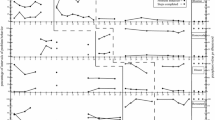Abstract
The family functioning of 30 nonhandicapped and 30 learning handicapped adolescents and their parents was examined. Measures of adaptability, cohesion, and communication were taken from the parent and the adolescent perspectives. Parent and adolescent perspectives on these areas of functioning were analyzed with a cluster analytic technique, which resulted in five distinct profiles of family functioning. These statistical groupings were confirmed by information gathered through participant observation from an accompanying investigation. The nature of the five clusters confirmed the existence of similar family functioning across the nonhandicapped and learning handicapped groups. Additionally, variations in reaction and adjustment to the amount of structure in the family environment by different families was documented. The importance of considering adolescent and parent perspectives separately was highlighted.
Similar content being viewed by others
References
Barnes, H., and Olson, D. H. (1982).Manual for the Parent-Adolescent Communication Inventory. Family Social Science, University of Minnesota, St. Paul.
Barnes, H., and Olson, D. H. (1985). Parent-adolescent communication and the circumflex model.Child Develop. 56: 438–447.
Begab, M. (1966). The mentally retarded and the family. In Phillips, I. (ed.),Prevention and Treatment of Mental Retardation. Basic Books, Newark, New York.
Bengston, V. C., and Kuypers, J. A. (1971). Generational difference and the developmental stake.Aging Human Develop. 2: 249–260.
Blos, P. (1979).The Adolescent Passage. International Universities Press, New York.
Elkind, D. (1967). Egocentrismic adolescence.Child Develop. 38: 1025–1034.
Florian, V. (1989). The cultural impact on the family dynamics of parents who have a child with a disability.J. Comp. Family Studies 20: 97–111.
Gliedman, J., and Roth, W. (1980).The Unexpected Minority—Handicapped Children in America. Harcourt Brace Jovanovich, New York.
Hill, J. P. (1980). The family. In Johnson, M. (ed.), Toward Adolescence: Seventy-Ninth Yearbook of the National Society for the Study of Education. University of Chicago Press, Chicago.
Lerner, R. M., and Knapp, J. R. (1975). Actual and perceived intrafamilial attitudes of late adolescents and their parents.J. Youth Adoles. 4: 17–36.
Mooney, R. L., and Gordon, L. N. (1950).Mooney Problem Check Lists. The Psychological Corporation, New York.
Morotz-Baden, R., and Colvin. (1989). Adaptability, cohesion, and coping stralegies of unemployed blue-collar families with adolescents.Lifestyles Family Econ. Issues 10: 44–60.
Morrison, G. M., and Zetlin, A. (1988). Perceptions of communication, cohesion, and adaptability in families of adolescents with and without learning handicaps.J. Abnorm. Child Psychol. 16: 675–685.
Murphy, M. (1982). The family with a handicapped child: A review of the literature.Develop. Behav. Pediat. 3: 73–82.
Murtaugh, M., and Zetlin, A. (1988). Achievement of autonomy by nonhandicapped and mildly handicapped adolescents.J. Youth Adoles. 17: 445–460.
Olson, D. H., McCubbin, H. I., Barnes, H., Larsen, A., Muxen, M., and Wilson, M. (1982).Family Inventories. Family Social Science, University of Minnesota, St Paul.
Olson, D. H., Portner, J., and Lavee, Y. (1985).FACES III. Family Social Science, University of Minnesota, St Paul.
Olson, D. H., Russel, C., and Sprenkle, D. (1983). Circumplex model of married and family systems: VI theoretical update.Family Process 22: 69–83.
Rodick, J. D., Henggeler, S. W., and Hanson, C. L. (1986). An evaluation of the family adaptability and cohesion evaluation scales and the circumplex model.J. Abnorm. Child Psychol. 14: 77–87.
SAS Institute. (1987).SAS/STAT Guide for Personal Computers Version 6 Edition. SAS Institute, Inc., Cary, NC.
Spivak, G., Haimes, P. E., and Spotts, J. (1967).Devereux Adolescent Behavior (DAB) Rating Scale Manual. The Devereaux Foundation, Devon, PA.
Steinberg, L. (1981). Transformations in family relations at puberty.Develop. Psychol. 17: 833–840.
Ward, J. (1963). Hierarchical grouping to optimize an objective function.J. Am. Stat. Assoc. 58: 236–244.
Weiner, I. (1985). Clinical contributions to the developmental psychology of adolescence.Genet. Social Gen. Psychol. 111: 195–203.
Wilkinson, L. (1986).SYSTAT: The System for Statistics. Systat, Evanston, IL.
Willner, S. K., and Crane, R. (1979). A parental dilemma: The child with a marginal handicap.Social Casework J. Contemp. Social Work 60: 30–35.
Youniss, J., and Smollar, J. (1985).Adolescent Relations with Mothers, Fathers, and Friends. University of Chicago Press, Chicago.
Zetlin, A. G., and Turner (1985). Transition from adolescence to adulthood: Perspectives of mentally retarded individuals and their families.Am. J. Mental Defic. 89: 570–579.
Zigler, E. (1969). Developmental versus difference theories of mental retardation and the problem of motivation.Am. J. Mental Defic. 73: 536–556.
Author information
Authors and Affiliations
Additional information
Received degree from University of California, Riverside. Research interests are in the area of the social development of at-risk or mildly handicapped children and adolescents in school and family settings.
Received degree from Teachers College, Columbia University. Research interests in social competence and family relations of learning handicapped populations as well as the development of family, community, and school partnerships.
Rights and permissions
About this article
Cite this article
Morrison, G.M., Zetlin, A. Family profiles of adaptability, cohesion, and communication for learning handicapped and nonhandicapped adolescents. J Youth Adolescence 21, 225–240 (1992). https://doi.org/10.1007/BF01537338
Received:
Accepted:
Issue Date:
DOI: https://doi.org/10.1007/BF01537338




